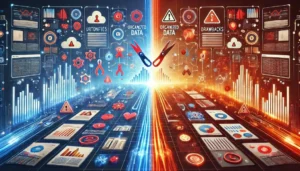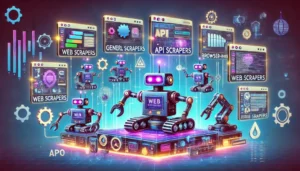What is Web Scraping and Why You Should Care?
Web scraping is an automated method of harvesting information from the internet. You can use powerful libraries such as BeautifulSoup,Scrapy and Latenode to save that data to databases and visualize or analyze it.
Key Takeaways
- Unlike web crawlers that index web pages for search engines, web scrapersare focused on extracting specific data elements.
- The process of web scraping includes making HTTP requests, parsing HTML, and storing data for easy retrieval and analysis.
- Web scrapers exist in various formats, including browser extensions and standalone software. Each type has its own benefits, especially when the task gets more complicated.
- For instance, in just about any industry, web scraping is used for monitoring competitors’ prices, market research, content aggregation, lead generation, and financial analysis.
- Legal and ethical considerations should be paramount. To stay out of court, you need to respect copyright, terms of service and data protection law.
Web scraping is an incredibly powerful tool for data collection. It helps you to more effectively scrape infinite quantities of data from websites. This approach increases our capacity to analyze data, accelerate research processes, and make data-driven decisions with real-time information.
By leveraging web scraping, individuals and businesses can access a treasure trove of data for market research, competitive analysis, and trend monitoring. Web scraping is most impressive with its flexibility and efficiency. It makes it possible to be a competitive force in almost every industry, acting as a fundamental building block in this data-driven era.
By embracing this technology, it ignites innovation and drives economic development. It gives users the tools they need to make the most of digital data.
What is Web Scraping?

Web scraping is a common technique for extracting data from the web. It’s the automated extraction of knowledge or collection of information from the WWW. This process is repeated by web scrapers, which are automated tools that are optimized to scrape large amounts of targeted data at scale quickly and efficiently.
This data is collected and sold to the highest bidder for purposes including data analysis and market research. Once collected, scraped data usually gets stored in local files to be manipulated, analyzed, or visualized. Bots are an indispensable part of this automation, providing the consistency and speed needed for data collection at scale.
1. Define Web Scraping
Web scraping is a process of automatically extracting content and data from websites for further analysis. It scrapes selected data from various websites, storing the information in local files for later use.
In contrast to web crawling, which is used to index web pages for search engines, web scraping is concerned with extracting data. It includes the use of bots to automate the data collection process, which allows you to speed it up and scale it.
2. Differentiate from Web Crawling
Web scraping is not the same as web crawling. Though web crawling is used to index web pages and help power search engines’ databases, web scraping is meant to pull specific data points to analyze.
Crawlers collect URLs to send back to scrapers, which can then be focused on data extraction. Web scraping works on both static and dynamic pages, including circumventing CAPTCHA barriers with machine learning models.
3. Explore Web Scraping Tools
Here’s a comparison table of various tools:
Tool
Features
Pricing
Usability
BeautifulSoup
Easy to use, Python-based
Free
High
Scrapy
Fast, scalable
Free to premium
Moderate
Latenode
Fast, scalable
14 days Free
Moderate
Choosing the best python web scraping tool often comes down to particular scraping requirements and project needs. With advanced tools, data quality is guaranteed, producing fewer errors and saving more time in the process.
How Web Scraping Works

Web scraping starts like any other browsing session by sending an HTTP request to the website you want to scrape. This first step is extremely important as it lays the groundwork for your data extraction. After the request is approved, the web scraper downloads the HTML or XML source code of the webpage.
Parsing this code is critical to be able to extract relevant information, such as product prices, user reviews, or other detailed information. Scrapers then look for useful tags and content. They then turn this raw data into structured formats such as CSV or JSON files, which allow for easier analysis and reporting.
1. Understand the Crawler’s Role
Web crawlers, known as web spiders or web bots, automatically scour the web to index all available web content. They are adept at crawling site after site, hyperlink by hyperlink, to scrape all the data in their path.
Ethical scraping includes respecting website protocols, such as a website’s robots.txt to prevent overwhelming a website’s servers.
2. Examine the Scraper’s Functionality
Scrapers identify the specific data elements they want to extract from the parsed HTML. Correct coding makes sure you will be able to extract it effectively, capturing exactly the information you want and nothing more or less.
This accuracy is important for accurate data gathering.
3. Utilize Web Scraping Software
Popular software options are Parsehub for beginners and Python libraries like Beautiful Soup for more advanced users. Ease of use, ability to export data, and support for complex scraping tasks are important features to look out for.
Implementation of software solutions has shown to be quicker and less prone to human error than desk-based techniques.
4. Perform Manual Data Extraction
Manual extraction works well in scenarios where automated tools aren’t able to, such as with CAPTCHA-protected pages. Inspecting elements and copying data one by one is time-consuming and tedious.
This approach is labor-intensive and more prone to human error than automated scraping.
Types of Web Scrapers
1. Overview of Various Scrapers
It’s important to note that web scrapers are not all created equal. Browser extensions and standalone tools are the first two on the list.
Browser extensions are more convenient and seamlessly fit into your surfing habits. They’re useful for simple, one-off tasks, such as extracting contact information from a web page. However, they may be constrained by browser limitations.
On the other hand, standalone tools provide significantly more power. They are designed to tackle bigger data sets and more complicated tasks, making them perfect for larger businesses that require more in-depth data scraping projects.
Standalone tools tend to have a bigger learning curve and take upfront setup and technical expertise. For example, bot developers would need programming skills or outsourced services to disrupt CAPTCHA designs when they are occurring.
Selecting the appropriate scraper is imperative to the task at hand. Easy data retrieval might require a browser extension, but complex data analysis might need a tool that exists outside of a web browser.
2. Compare Open Source and Commercial Tools
Feature
Open Source Tools
Commercial Tools
Cost
Free or low cost
Subscription or license
Support
Community-based
Professional support
Flexibility
Highly customizable
Generally less flexible
Ease of Use
Requires technical skills
User-friendly
Open-source tools really shine in customization and cost-saving. They work best with users who are comfortable customizing software.
While these tools are more expensive, they provide a level of ease-of-use and dedicated support that can be valuable. The trade-off is between flexibility and ease of use.
Open-source is flexible but requires high level tech skills. Commercial solutions offer faster, lower-tech installations, better suited to those who are willing to sacrifice some customization for speed.
Applications of Web Scraping
Web scraping is an invaluable asset to any industry helping businesses make data-driven decisions and improve overall business intelligence. It enables fast, automated data collection, providing real-time insights and more informed decisions.
Businesses leverage scraping to track competitor pricing, monitor supply chain risks, and collect data from social media sites like Facebook and Twitter to understand customer sentiment. This data-driven approach allows them to create more effective, targeted marketing strategies and cultivate insightful relationships with customers.
1. Implement Price Monitoring
Retailers and other businesses utilize web scraping to track price updates as they happen, tracking competitor pricing and product availability. This intelligence drives more strategic business decisions, such as pricing competitively while maximizing profit margin.
By automating their price tracking, businesses are able to stay competitive in the ever-changing world of e-commerce.
2. Conduct Market Research
Market research firms use web scraping to gather large amounts of data. They apply sentiment analysis to predict customer behavior, which informs their marketing strategies.
Accurate data is vital for understanding market trends and consumer preferences, providing a competitive advantage.
3. Monitor News and Content
Web scraping is key to monitoring news articles and online content, utilizing a web scraper to provide an aggregated look at information from countless sources. By employing the web scraping process to gather data from competitors, businesses can make informed decisions and enhance strategic planning.
4. Generate Leads and Automate Business
Enhancing efficiency, automating lead generation using web scraping saves time and resources. By collecting data from social media, review sites, reservations, websites, and more, companies save time, reduce manual processes, and grow their business faster.
Automation serves as a foundation for future growth and maximized resource use.
5. Use in Real Estate and Finance
Real estate firms utilize the web scraping process for property listings and market analysis, while finance sectors track stock prices and financial news. Real-time data is essential for making smart investment decisions, with web data extraction fueling robo-advisors to deliver professional-level analysis at scale.
Legal and Ethical Considerations
Web scraping is an issue at the intersection of technology, law, and ethics. It’s important to understand copyright and terms of service. Copyright laws impact the things you can do with any data you scrape from websites.
Always check a website’s terms of service before scraping. Disregarding them may be a violation of your contract. Breaches of these terms would lead to enforcement actions, such as cease-and-desist letters or even litigation.
In some jurisdictions, web scraping could be considered an act of trespass to chattels. This would require hacking into someone’s computer system, which itself would constitute a violation of the Computer Fraud and Abuse Act (CFAA).
When dealing with personal data, the ethical considerations should always come first. Adherence to data protection regulations such as the EU’s GDPR and California’s CCPA are important. These regulations further users’ privacy and control over their data.
Some of these best practices are to anonymize data and make sure sensitive information is protected. Ethical concerns also arise with web scraping. When scraped data is used maliciously, it can cause serious harm to people or companies.
By following ethical guidelines, we can use the data we’ve collected to inform our decisions in a more responsible way. It further protects the rights of those around you. Understanding these factors is key to performing legal and ethical web scraping activities.
Benefits and Drawbacks of Web Scraping
1. Identify Advantages of Scraping
Web scraping’s greatest strength is in the efficiency and speed it brings, allowing for data collection at a much quicker pace compared to human methods.
Inexpensive and accessible sentiment analysis is another key advantage. Businesses and researchers can easily scrape thousands of consumer reviews to perform sentiment analysis across them. This methodology is time-saving and very cost-effective.
By automating their data collection, organizations can get a 90% return on investment or higher. This makes it an extremely effective one-time investment that delivers long-term returns.
Web scraping is a method of gathering massive amounts of information at once from various locations. This highly structured data goes straight into databases or spreadsheets as a basis for more in-depth analysis.
This new capability greatly enhances the ability to make data-driven decisions. It provides companies the opportunity to monitor trends and respond faster to new market developments, providing them the competitive advantage.
2. Discuss Potential Challenges
Web scraping has its drawbacks. Bot detection is a frequent obstacle, since websites use techniques to prevent automated access.
Monitoring dynamic websites through scraping introduces technical complications, including the need for advanced tools and expertise. Maintenance and updates to scraping tools are important because websites often change their format.
Despite these challenges, a thoughtful and balanced approach can help ensure these tremendous benefits are maximized. Automating repetitive tasks such as monitoring changes to websites gives you more time to focus on higher level, more strategic projects.
By thoughtfully considering these benefits and drawbacks, firms can make more informed business decisions and succeed in the race to remain competitive.
Conclusion
Web scraping can lead to previously inaccessible data. It pulls down data in an instant, eliminating dozens of hours of manual effort. Companies can identify consumer trends faster, and marketers can identify new customers. Smart developers are creating some really cool tools that utilize this real-time data. It’s a miracle worker in fields ranging from retail to technology. Do make sure to keep things legal and ethical. Always respect site terms of service and privacy laws. Weigh the positive and negative impacts to inform better decisions. Explore the world of web scraping and unlock the big data ocean. It’s no longer all about code, it’s about what you do with the data. Want to learn more about using data to improve transportation? Find tools and how-to guides to help you get started. Don’t miss your opportunity to learn how web data can benefit you.
Frequently Asked Questions
What is web scraping?
Web scraping is the practice of using a web scraper to automatically extract data from websites, which can then be utilized for analysis or integrated into other applications.
How does web scraping work?
Web scraping is the practice of using a web scraper to extract data from websites. These tools mimic human internet browsing and automate data extraction from the web based on structured queries.
What are the types of web scrapers?
Various types of web scrapers exist, including HTML parsers, DOM parsers, and browser web scrapers, each fulfilling distinct needs in the web scraping process, from basic to advanced complexity and data consumption.
What are the applications of web scraping?
Web scraping is widely used in industries such as market research, price scraping, content aggregation, and lead generation. This web data extraction process enables organizations to gather data for better, more informed business decisions.
Are there legal considerations in web scraping?
In short, the legality of the web scraping process is determined by the underlying website’s terms of service and data usage policies. So be sure to check the legality of your web data extraction to avoid a lawsuit.
What are the benefits of web scraping?
Web scraping streamlines the web scraping process, allowing you to save time and money while gathering data. It provides you with real-time insights and aids in performing a competitive analysis.
What are the drawbacks of web scraping?
The web scraping process can lead to costly legal battles when abused, and it may cause significant data inaccuracy if hard-coded, especially as websites change their structure f
